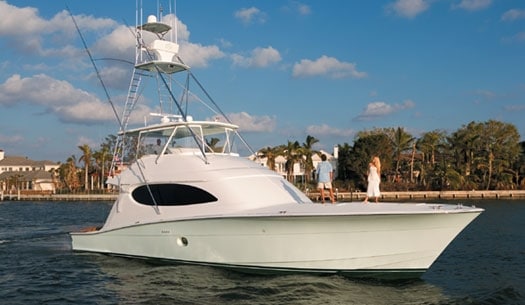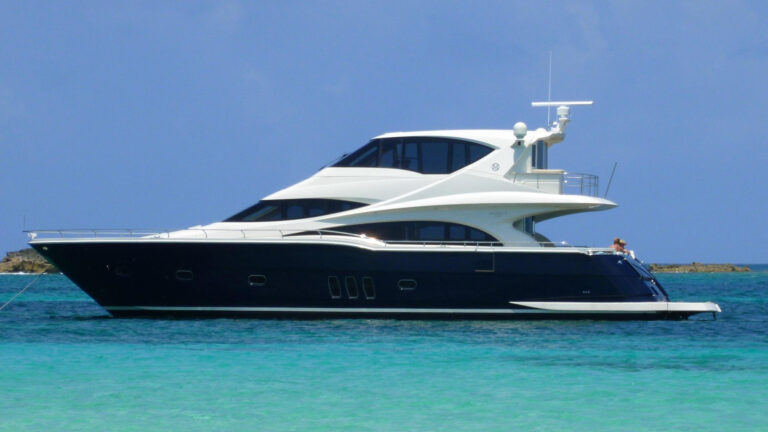
An extra foot and a half of beam gives the 64 a more ample saloon, as well as easy footing and stability.
The wind was blowing out of the southeast at 20 to 25 knots and the seas were running 10 feet plus—not the sort of day that most folks would look forward to for fishing. Such conditions, however, are just the brew that large Hatteras convertibles are designed for, so I knew before I arrived at Sailfish Marina in Palm Beach that Hatteras’ new 64 Convertible would be ready for sea.
I was met dockside by David Ritchie, Hatteras’ director of marketing, as well as Captain Dave Fields and his mate Danny Weid. As we were all veterans of foul-weather fishing there was no second-guessing-we cast off and headed for Palm Beach Inlet. While wide and deep, it had plenty of current to stir things up and the out-going tide was creating steep, confused seas. Fields nosed the 64 ahead easily with just enough throttle to keep her bow engaged with the breaking waves. As we passed through a solid 12-footer, we realized that the anchor locker hatch was ajar. Calmly, Fields reduced headway and after waiting out another steep sea, swung the 64 around in her length and headed back into calm water. Weid secured the hatch and we were off.
If you’ve browsed Chapman’s treatise on seamanship you may remember that steep seas in inlets are not to be trifled with. Fields was able to execute the about-face with confidence because the 64 features a key asset that lends itself to such a challenge. It has little to do with hull form, although the 64 is rather unique. It is not a matter of balance or proportion, although her form and appearance are seakindly as well as pleasing to the eye. It is all about horsepower and how it is transmitted to the water. With a pair of 1,800 hp Caterpillar C32’s, the 64 has the necessary muscle, but it is her 3:1 reduction and pair of seven-blade, 40- by 68-inch propellers that really make the difference; this is where the rubber meets the road. The traction that a deep reduction and generous propeller blade area allow is very noticeable when it comes time to spin a 100,000-pound boat or climb a steep sea.
While running inlets to pursue game fish offshore is in Hatteras’ DNA, in recent years its approach to design has changed. In the past Hatteras’ hull forms for the most part evolved from one to another. For example, in the 1980s the 60 begat the 65 and the 65 begat the 70 and so on. The result was beam-length ratios were stretched and seakeeping and speed were achieved by adding horsepower to longer, leaner forms. When these boats earned their retirement from production, the Hatteras design team chose to pen its new designs on a clean sheet of paper.
Last year I fished aboard the 68 Convertible, one of the first of this new generation. Like the 68, the 64 is relatively wide for her length with a maximum beam of 19 feet, 6 inches compared with the 18-foot beams of the late 60-, 65- and 70-foot convertibles. Her hull form is also a departure from the norm, with deep, slightly convex sections forward that transition to a deadrise of just two degrees at her transom. This shallow deadrise angle maximizes lift, while propeller pockets keep draft to just 4 feet, 10 inches. While some might feel that deeper transom deadrise is called for, I believe increased deadrise is appropriate for the portions of the hull that reside in the air-water interface-where wave impacts occur. Given responsible operation and the 64’s speed and mass, this impact zone will most likely be forward of amidships.
In terms of mass, the 64 is built like a tank. While some builders achieve high speed by investing in lightweight structures, Hatteras has always taken a more conservative path. The 64’s bottom is solid fiberglass. Coring is used to stiffen the hull sides, decks and superstructure. Fuel is carried in UL-approved fiberglass tankage-a traditional feature on Hatteras yachts. The hull and superstructure have a molded gelcoat finish that is prepped and painted with Awlcraft 2000. Below the waterline a coat of vinylester resin skin and an epoxy barrier coat help reduce the chance of blistering.
Punching through 10-foot head seas you can really appreciate the 64’s blend of physical mass and deep-reduction muscle. Advance the throttles and she responds steadily, engaging the sea without a hint of hesitation or stagger. Running in a beam sea and bow-quartering sea we managed 27 knots comfortably while the big Cats loafed along at 1900 rpm. At trolling speeds the 64 is rock-solid thanks in large part to that shallow transom deadrise. Trolling valves allow her to loiter at a snail’s pace. Considering the 64’s bulk, sight lines from the bridge are excellent and when it comes time to fuss with a fish her deep reduction allows her to twist and turn like a boat half her size. While conditions were not suitable for a formal sea trial, Fields indicated that he consistently sees a maximum speed of a bit more than 35 knots fully loaded and likes to cruise at 2000 rpm, approximately 30 knots.
The 64’s machinery space is accessible from the cockpit. The nuts and bolts of Hatteras’ onboard systems have set the industry standard for decades. In recent years, inspired by custom fish-boat competition, the builder has refined this solid foundation with a high-gloss presentation that is second to none in the production market. The 1,800 hp Caterpillars fit easily in the 64’s beamy well-lit engine space. Fuel filters are at hand on centerline and the main 12V DC electrical distribution panel is forward. There are a variety of engine options, but given the 64’s mass I would suggest the hearty offerings-the 1,800 hp C32 Caterpillars or the 1,800 hp MTU 12V-2000s.
I spent most of my time aboard the 64 manning her teak-sheathed cockpit. The layout is clean and simple with no hard edges. There’s tackle storage in removable tubs under the mezzanine sole and a freezer under the bench seating. A refrigerated drink box is located under the steps and a small bait-prep center has drawers and gaff storage. With the horizon blocked by steep following seas, Ritchie, Weid and I dealt with four bent rods without stumbling over one another and managed to bring half a dozen dolphin aboard and deposit them in the ice-machine-equipped, in-sole fish box—one of two 62-inch longitudinal boxes that are fitted with a macerator. Our test boat was set up for light- tackle sailfishing with a Release Marine rocket launcher with a rigging tray and drawer. A full-size chair is offered as an option.
Given the weather, I was pleased to find the 64’s bridge was protected with a three-sided enclosure fitted to a PipeWelders tower. A pair of Release Marine helm chairs and a teak helm pod and single-lever tournament-style controls are in keeping with custom fish-boat fashion. With a push of a button, an electronics bay with space for four large displays flips into position from within the console. An additional space with a hinged cover houses radar and sounder control heads and lesser electronics. A seating area forward of the console has rod storage and a freezer within. A rear-facing spotter seat has a built-in insulated drink box. The 64 is also available with an enclosed bridge with a helm-forward arrangement and either interior or exterior access.
You sense Hatteras’ beamy new interior volume immediately when you step into the main cabin. The split-level layout has an oversized sofa-style seating area with a table that faces a built-in 42-inch plasma TV. The raised area forward is an open-galley arrangement with drawer-style under-counter refrigeration. A dinette area is an arm’s length away. The biggest surprise is below. The 64’s three-stateroom, three-head arrangement includes a full-beam owner’s stateroom with a king-sized berth. Alternate layouts include a four-stateroom arrangement and a three-stateroom arrangement with an office. The fit and high-gloss finish of the American black cherry interior joinerwork is first class. Little touches, like the discreet air-conditioning discharges integrated in the joinery, reveal the attention Hatteras has devoted to the design. Solid-surface countertops, quality soft goods and Euro-style fixtures and hardware support the upscale presentation.
The 64 has an estimated base price of $3 million with the 1,800 hp Caterpillars. She is an impressive ride with a stout feel and a tenacious approach to seakeeping that one must experience to appreciate. There are production boats that require less of an investment and custom boats that are faster, but few are as soft to the touch, as pleasing to the eye and as capable as the Hatteras 64.
Contact: Hatteras Yachts, (252) 634-4895; _www.hatterasyachts.com_









